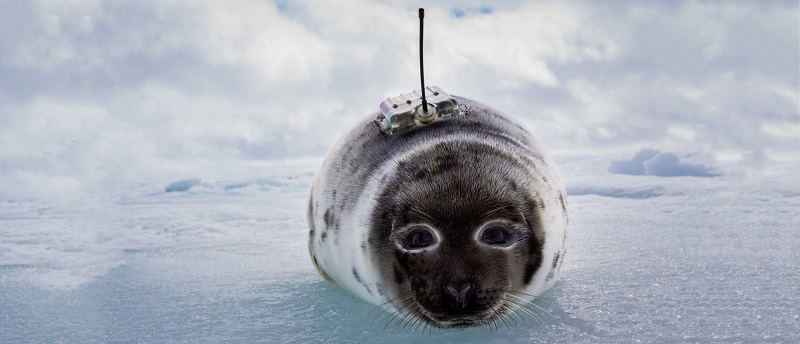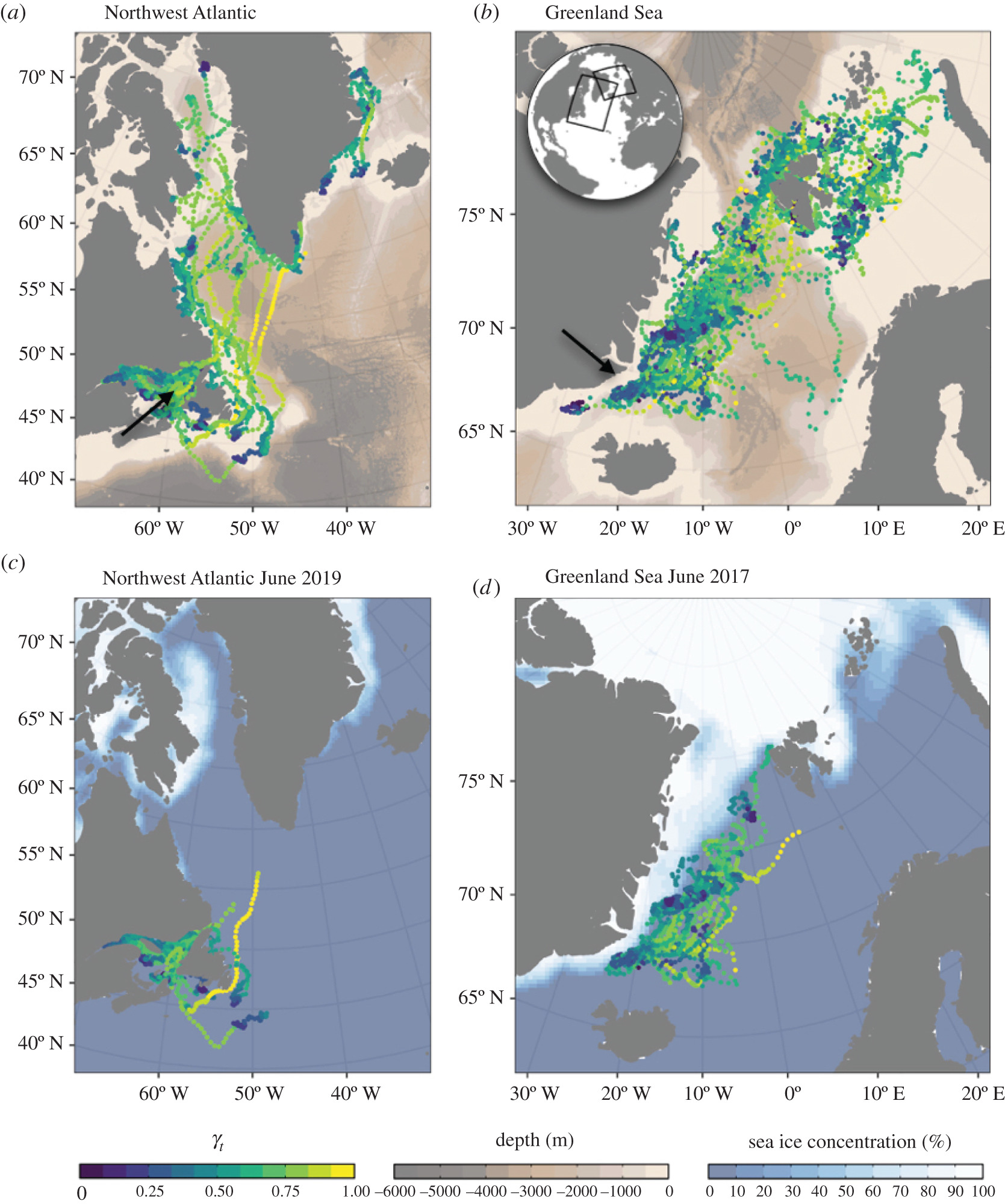← Back
Harp seal juveniles learn on their own

Harp seal juveniles leave their native ice pack to forage and migrate on their own. Tracking them and recording their dive can help understand how they manage their first year. Ultimately, the question is their plasticity with respect to environmental changes.
Photo: a juvenile harp seal with an Argos PTT (credit W.J. Grecian, SMRU)
Harp seals (Pagophilus Groënlandicus) are the most abundant marine mammals in the Northern Hemisphere. They are ice-dependent, migrating seasonally between subarctic north Atlantic and Arctic (40°N–85° N). The pups are nursed on the open ice pack by their mother for 10 to 12 days, which is enough for them to more than double their body mass. After weaning, they stay on their own, fasting on the ice for about three weeks, when they build up muscle mass and oxygen storage capacity, before taking to the sea pon their own (like a number of other marine animals such as very young green turtles go into the Sargasso Sea or Argos helps in revealing how juvenile emperor penguins learn to feed or non-marine ones Juveniles black-tailed godwit tracked).
However, the movements of young seals after weaning are poorly known, as the way their migratory and dive behaviour develop over their first year of life, both vital behaviours. In particular, as air-breathing animals, they need to learn how to manage their air for dives, and how to catch prey at the same time.
Tracking juvenile harp seals in their first year
In April 2017, 26 juvenile seals were captured on the pack ice east of Ittoqqortoormiit in the Greenland Sea. In March 2019, 12 newly moulted seals were captured and tagged on pack ice in the Gulf of St Lawrence, Canada. These represent two of the three main population areas for harp seals. 16 and 10 tags respectively had recording and transmitting information capabilities about the individuals’ dive behaviour (SMRU instruments), the others were recording temperature. All transmitted positions.
The recorded data represented a total of 6084 seal-days and 14 130 individual dive profiles. During this time animals travelled up to 3500 km from the breeding areas and covered an estimated distance of up to 16 700 km. Differences and similarities were noticed between the two populations’ behaviours. The return of the migration was mostly not recorded, the tags having stopped before.
More info about animal tracking with Argos

Migratory paths for (a) Northwest Atlantic (12 individuals) and (b) Greenland Sea (26 individuals) juvenile harp seals tagged in 2019 and 2017, respectively, overlaid on bathymetry. Movements of (c) Northwest Atlantic and (d ) Greenland Sea seals up until June overlaid on average sea ice concentration for that month. Arrows indicate tagging locations. Colours of the points represent the move persistence estimate (γt) from state-space model filtered locations; low persistence (dark blue) is assumed to indicate periods of residency (seals move around without main direction) and high persistence (light green-yellow) is assumed to indicate periods of transitory behaviour/migration (seals continues on in the same direction) (from [Grecian et al., 2022]).
Different behaviours depending on the starting points
Overall, the young seals from both populations used similar areas than adult harp seals of the same region.
The two areas differed on the migration date (which is also the case for adults), with seals from the Greenland Sea leaving from the beginning of May towards north of the 70° N parallel. Those from Northwest Atlantic remained in the Gulf of St Lawrence for several month. Migration begun in earnest early July, towards either north along the Labrador coastline in shelf waters, or crossing the Labrador Sea and spending time along the east or west coast of Greenland
Moves were correlated with bathymetry and sea ice concentration for both populations, with individuals travelling faster over deep water (more slowly in shallow waters). Their path tended to be more tortuous in areas of higher sea ice concentration. Greenland Sea animals were more closely associated with sea ice than Northwest Atlantic animals, though.
Analysis of the diving behaviour shows the low capabilities of all the juvenile seals when they begin independent foraging. They made more dives, which were much shorter and shallower than adults’. Their dive behaviour developed rapidly, though, in both juvenile populations tracked. However, after 25 days, the two populations diverged on their dives, with Northwest Atlantic individuals increasing dive duration and depth, while the Greenland Sea ones decreased those. These differences may be attributed to the different environments available at that time. Previous studies suggest adult harp seals dive shallowly along the ice edge to target ice-associated prey. Northwest Atlantic juveniles were still in the shallow waters of the Gulf of St Lawrence with little ice at that time, while the Greenland Sea ones were in very deep water.
Impacts on survival
The conditions experienced by juveniles as they gain independence during their first year impact their survival. In the meantime, their living areas are undergoing rapid ecosystem changes. Both adult body condition and young of the year survival have declined in recent years, and understanding the link between the two is important for conservation of the species.
Reference & links
- Grecian, W. James; Stenson, Garry B.; Biuw, Martin; Boehme, Lars; Folkow, Lars P.; Goulet, Pierre J.; et al. (2022): Environmental drivers of population-level variation in the migratory and diving ontogeny of an Arctic top predator. Royal Society Open Science. https://doi.org/10.1098/rsos.211042
- Changing Arctic ocean Program
- Sea Mammal Research Unit (SMRU) at StAndrews University
